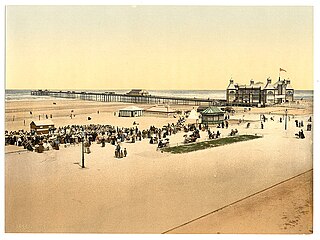
Denbighshire is a county in the north-east of Wales. It borders the Irish Sea to the north, Flintshire to the east, Wrexham to the southeast, Powys to the south, and Gwynedd and Conwy to the west. Rhyl is the largest town, and Ruthin is the administrative centre. Its borders differ from the historic county of the same name.

Until 1974, Flintshire, also known as the County of Flint, was an administrative county in the north-east of Wales, later classed as one of the thirteen historic counties of Wales.

Rhyl is a seaside town and community in Denbighshire in Wales. The town lies on the coast of North Wales, at the mouth of the River Clwyd.

Prestatyn is a seaside town and community in Denbighshire, Wales. Historically a part of Flintshire, it is located on the Irish Sea coast, to the east of Rhyl. Prestatyn has a population of 19,085.

The Borough of Rhuddlan was a local government district with borough status from 1974 to 1996, being one of six districts in the county of Clwyd, north-east Wales.

Denbighshire County Council is the unitary local authority for the county of Denbighshire, one of the principal areas of Wales. The council is based at County Hall in Ruthin.

Trevalyn Hall in Rossett, a Grade II* listed building, is an Elizabethan manor house near Wrexham in Wales. It was built by John Trevor in 1576. The Trevor family of Trevalyn were one of the leading families in East Denbighshire by about 1600 with numerous estates in both Flintshire and Denbighshire. The Plas Teg estate in Hope, Flintshire was also acquired by the Denbighshire branch of the family when it was purchased from a cousin by Sir John Trevor I (1563–1630) and it was he who built the present Plas Teg house in 1610.

Ambrose Hall, located in Davenport, Iowa, United States, is the first building constructed on the campus of St. Ambrose University. It was listed on the National Register of Historic Places in 1977.
Arthur Cheetham was an English-born Welsh filmmaker, who became the first of his profession to be based in Wales. His legacy is a collection of eight surviving films, including one of the oldest extant British football 'shorts' from 1898. Cheetham, along with fellow cinematic pioneer, William Haggar, are recognised as the only Welsh-based film makers of importance before the First World War.

Ruthin Town Hall is a municipal facility in Market Street, Ruthin, Denbighshire, Wales. It is a Grade II listed building.

Rhyl Pier, officially known as the Victoria Pier, was a pleasure pier in the seaside town of Rhyl, Flintshire, and the first to be built in North Wales. Designed by James Brunlees and opened in August 1867 at a length of 2,355 feet (718 m), it was the town's central attraction for the ensuing years. Following dispute and public consultation regarding the location it would be built, the pier was constructed near the centre of the esplanade. The pier's Grand Pavilion, built in 1891, featured the world's largest organ, known as the Grand Jubilee Organ and weighed 25 tonnes.

Nelson Town Hall is a municipal building in Market Square, Nelson, Lancashire, England. The building is the headquarters for both Pendle Borough Council and Nelson Town Council.

Llandudno Town Hall is a municipal structure in Lloyd Street, Llandudno, Wales. The town hall, which serves as the meeting place of Llandudno Town Council, is a Grade II listed building.

Larne Town Hall is a municipal structure in Upper Cross Street in Larne, County Antrim, Northern Ireland. The structure, which was the meeting place of Larne Borough Council, is a Grade B+ listed building.

Elland Town Hall is a municipal building in Southgate, Elland, West Yorkshire, England. The structure, which was primarily used as an events venue, is a Grade II listed building.

Flint Town Hall is a municipal structure in the Market Square, Flint, Flintshire, Wales. The town hall, which is the meeting place of Flint Town Council, is a Grade II listed building.

Holyhead Town Hall is a municipal structure in Newry Street, Holyhead, Wales. The town hall is the meeting place of Holyhead Town Council.

Mold Town Hall is a municipal structure in Earl Road in Mold, Wales. The town hall, which serves as the meeting place of Mold Town Council, is a Grade II listed building.

Holywell Town Hall is a municipal structure in the High Street in Holywell, Wales. The façade of the town hall, which is the only surviving part of the original structure, is a Grade II listed building.

County Hall is a municipal building in Wynnstay Road, Ruthin, Denbighshire, Wales. The structure is the headquarters of Denbighshire County Council.




















